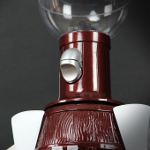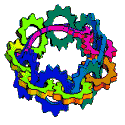|
Indecisive posted:You will never have 4 saturated belts if you're taking material off though, so why run 4 belts that are half full when 2 full belts is equivalent? Belts and splitters entitlements can get lost in using the bus as a giant warehouse for WIP. The tree idea is over designed for the sort of production most people do, but if you find your factory calling your bluff about what can actually spit out the option is there to do the production accounting and keep everything full when a big user spins up. A tree would help production accounting because the entitlement calculation is very easy: a full belt gives half a full belt out of a splitter. Dirk the Average posted:Because you're not always running all parts of your factory at once. If an early part of your factory shuts down, it's useful to have the rest of the plate move on to the rest of the factory. At the very least you have known sinks in rocket parts, and research if you have an endless research mode. Solumin posted:Sure, the tree could work. Is this a design you've used before?
|
|
|
|

|
| # ? Apr 25, 2024 07:29 |
|
Solumin posted:
I have a pretty clean copper and iron line that other things draw from, but when so many of the advanced goods require green circuits, everything turns to spaghetti.
|
|
|
|
Solumin posted:
It's fake saturation though, because it's all backed up and hence not making full use of the available throughput. If you add another load to the end that consumes all those plates, it will thin out rapidly. More to the point, you could just remove the excess belts without any negative impact. Your maximum throughput is when you have the full four belts of material at the start of the bus. If you take material off the bus to build something, then the available throughput downstream of that point is lower than the initial maximum, even if you're still spreading it over four belts.
|
|
|
|
I love this thread. Your designs are amazing. Also, I think your arguments about the 4-belt bus are invalid. The guy said he uses splitters after a belt branches off to an assembly line to even things out, and more often than not, parts of your factory work slower or shut down completely, which means you'll end up having fully saturated belts. On top of that, if your production is more than your consumption, you'll always have fully saturated belts. If I were to use the 4-bus method or the tree-branch method, I'd go for the 4-bus.
|
|
|
|
Jabor posted:More to the point, you could just remove the excess belts without any negative impact. Loopoo posted:I love this thread. Your designs are amazing. Also, I think your arguments about the 4-belt bus are invalid. The guy said he uses splitters after a belt branches off to an assembly line to even things out, and more often than not, parts of your factory work slower or shut down completely, which means you'll end up having fully saturated belts.
|
|
|
|
WhiteHowler posted:Can you post a screenshot of your green circuit board manufacturing area for that factory? Sure:  Full disclosure, I stole it from Ratzap's posts about the factory he built while following Negative Root's playthrough: Ratzap posted:Yup, this is my factory from shadowing Negative Roots playthrough found here. You can see the furnaces at the bottom, then the bus coming up from it - copper and iron to start with, then green circuits adds in, then steel, then gear wheels and finally red circuits. I can post a better zoomed in shot if you like. Also note this example is still a little cramped, I would have left a bit more room but I wanted to follow the tutorial and see how he built it. Jabor posted:It's fake saturation though, because it's all backed up and hence not making full use of the available throughput. If you add another load to the end that consumes all those plates, it will thin out rapidly. More to the point, you could just remove the excess belts without any negative impact. When I have time today or tomorrow, I'll play around with it and see how it holds up when there's serious draw on it. Maybe post a video or some gifs, if I can. In the meantime, here it is with 3 of the factories pulling some serious iron:  (That's the green circuit factory, the red circruit and battery sections of the blue science factory, and the blue belt factory all going full tilt.) Part of the fun of Factorio is finding a bottleneck, fixing it, and waiting for it to ramp up to see if it's actually fixed or not. I'd have to have all of my factories running for a while to clear the backlog of iron, at which point we could actually see how it handles unsaturated belts.
|
|
|
|
It looks like you only have one-and-a-half red belts of iron coming into the bus, so that's almost certainly going to be the bottleneck once you've burned through the stuff buffered on belts.
|
|
|
|
Every time you run a faster belt into a slower splitter, it slows the speed down to the same color belt as the color of the splitter.
|
|
|
|
Loopoo posted:I love this thread. Your designs are amazing. Yeah, this is a seriously great thread. So much cool stuff! Jabor posted:It looks like you only have one-and-a-half red belts of iron coming into the bus, so that's almost certainly going to be the bottleneck once you've burned through the stuff buffered on belts. Yes, I only have 2 parallel iron foundries, and I don't have much room to expand. This was my time trying a high-capacity 4-belt bus, all of my previous factories have had much smaller buses, and I've never progressed this far before. So I didn't have a good idea of how much iron plate throughput I would need on the production end. Lesson learned! It does work well enough most of the time though. My next game will have a larger factory with more things automated, which means a lot more (parallel) iron and copper production. I'd be interested in hearing about how you set up your factories, or if you use a bus at all. FISHMANPET posted:Every time you run a faster belt into a slower splitter, it slows the speed down to the same color belt as the color of the splitter. Yup. I was upgrading splitters and belts as I encountered problems, so not everything is blue yet. (And probably won't be, I'm planning on starting a new game soon. I have a problem.)
|
|
|
|
Most of the well designed factories I see here seem to do all of their ore smelting at or near the manufacturing center. I usually put my furnaces right out by the ore fields, then train in the plates (and sometimes steel too). Is there a particular reason to bring in ore vs. plates if your mines are far enough away to require train transportation? Also, when making steel plates, how many furnaces should I have per electric drill/iron plate making furnace combo? I was doing one-to-one, but the steel plates seem to take much longer to build than the iron plates feeding in. I'm probably doing this part of it way wrong.
|
|
|
|
Steel takes 5 times as long to smelt as iron, but also requires 5 pieces of iron. In the time you smelt 5 pieces of iron, you smelt 1 steel. So if you have one iron furnace feeding into one steel furnace, they'll both always be working. As far as ratio of drillers to furnaces, always more drills. You can calculate it, but there's not really much point in it. If you build the exact right amount of drillers on a patch, eventually some will go dry and throw off your ratios. So just cover the patch in drills until it's not enough, then find another patch and cover it with drills.
|
|
|
|
WhiteHowler posted:Most of the well designed factories I see here seem to do all of their ore smelting at or near the manufacturing center. I usually put my furnaces right out by the ore fields, then train in the plates (and sometimes steel too). Transporting plates is twice as efficient as transporting ore, as plate stacks are 100 units while ore stacks are only 50. Steel is even more efficient, as it takes 5 iron ore to make one steel plate. However, taking advantage of this requires rebuilding your foundry infrastructure every time you open a new mine. Most players find it easier to run a few more trains than to build a new foundry (and an enlarged defensive perimeter) every time they open a new outpost. For mining speed, according to the wiki an electric drill produces 1 unit every 2 seconds, a smelter makes one iron plate every 3.5 seconds, and a smelter makes one steel plate every 17.5 seconds. Steel plates take longer than iron plates, but it ends up even because one steel plate requires five iron plates.
|
|
|
|
WhiteHowler posted:Most of the well designed factories I see here seem to do all of their ore smelting at or near the manufacturing center. I usually put my furnaces right out by the ore fields, then train in the plates (and sometimes steel too). Ore is smelted 1 to 1 so you gain nothing by producing your plates by the ore field. Concrete requires iron ore so once again, you want at least some making it to the factory area. If you smelt at the ore, when the ore runs out are you going to move the smelters to the new patch? Easier all round and for longevity of the smelting area to just ship in ore. If you're smart, you can build smelter blocks from word go which allow electrics to be dropped in later along with the spaces for beacons. For steel as Fishmanpet said (and I wrote a few times previously) - iron smelts 1 to 1 with steel. Steel takes 5 iron and makes 1 steel in 17.5s, iron ore goes to a plate in 3.5s - 3.5 x 5 = 17.5. I usually build a steel only line with 16 furnaces in a double row (spaced for upgrades) - the first 8 produce iron and feed the second 8 which make steel. Simple and it doesn't eat your iron output but of course requires it's own ore feed.
|
|
|
|
Microcline posted:Transporting plates is twice as efficient as transporting ore, as plate stacks are 100 units while ore stacks are only 50. Steel is even more efficient, as it takes 5 iron ore to make one steel plate. However, taking advantage of this requires rebuilding your foundry infrastructure every time you open a new mine. Most players find it easier to run a few more trains than to build a new foundry (and an enlarged defensive perimeter) every time they open a new outpost. Couldn't you just have a dedicated smelting outpost that has ores shipped in to it, and then have it's products shipped out to your main manufacturing base? That's what I'm doing. It allows me to build megahuge smelting arrangements and I just ship out tonnes of metal to my pretty base.
|
|
|
|
So I took a screenshot of my base with the ingame screenshot function and stitched the 4 images together. It's 19k*19k pixels and 550mb. What do I do now?
|
|
|
|
Host it on imgur and absolutely do not embed it in your posts?
|
|
|
|
Make it smaller.
|
|
|
|
Ratzap posted:Ore is smelted 1 to 1 so you gain nothing by producing your plates by the ore field. Concrete requires iron ore so once again, you want at least some making it to the factory area. If you smelt at the ore, when the ore runs out are you going to move the smelters to the new patch? Easier all round and for longevity of the smelting area to just ship in ore. If you're smart, you can build smelter blocks from word go which allow electrics to be dropped in later along with the spaces for beacons. Ore is smelted 1 to 1, yes, but plates stack in 100s while ore itself stacks in 50s, so your trains can hold twice as many plates as ore.
|
|
|
|
Solumin posted:Sure: As a newbie, looking at your splitter surrounded by four splitters hurts my head. I'm sure it splits four belts evenly but I can't visualize it. Negative Root's beginner's playlist explain this eventually?
|
|
|
|
I'm not sure how that setup properly divides into 4 lanes, since some routes through it cause the items to move through more splitters than other routes.
|
|
|
|
Mindblast posted:I'm not sure how that setup properly divides into 4 lanes, since some routes through it cause the items to move through more splitters than other routes.
|
|
|
|
Mindblast posted:I'm not sure how that setup properly divides into 4 lanes, since some routes through it cause the items to move through more splitters than other routes. Indeed, my understanding is that it is biased towards one of the output belts. I think the bottom one? I'm not sure, but it works well enough. Node posted:As a newbie, looking at your splitter surrounded by four splitters hurts my head. I'm sure it splits four belts evenly but I can't visualize it. Negative Root's beginner's playlist explain this eventually? I don't think Negative Roots covers it -- I got it from an earlier post in this thread. (There are a lot of very, very useful things in this thread.) Try thinking of it with only 1 input belt full at a time and visualize where each split goes.
|
|
|
|
Yeah as Zed says, it's a level of perfection that is not required. I just started looking closer since Node commented on it. 
|
|
|
|
Solumin posted:Indeed, my understanding is that it is biased towards one of the output belts. I think the bottom one? I'm not sure, but it works well enough. If the input belts are loaded (left to right) 100%, 100%, 0%, 0%, the output belts will be 75%, 75%, 25%, 25% Telarra fucked around with this message at 21:47 on Mar 26, 2016 |
|
|
|
Solumin posted:I don't think Negative Roots covers it -- I got it from an earlier post in this thread. (There are a lot of very, very useful things in this thread.) Try thinking of it with only 1 input belt full at a time and visualize where each split goes.
|
|
|
|
If you understand the concept of a splitter then you can visualise the potential routes that flow through it. What are you having a hard time with at this point? Just eyeballing how it flows?
|
|
|
|
zedprime posted:That's the practical method of throw splitters at it vs bulkier perfect balancing schemes as explained in this reply last night To clarify: using perfect balancers for your bus isn't just impractical, it gives zero additional value over imperfect balancing. A resource bus can essentially be in one of three states: 1: All your resource sinks have full inputs. The belt balancing of the bus is irrelevant. 2: Some of your resource sinks do not have full inputs and some of your sources have full outputs. There is objectively some problem with how your belts are organised and you should fix it. 3: Some of your resource sinks do not have full inputs and all your sources are outputting at full pace. Where and how you balance the bus is purely a matter of which sinks you want to prioritize over others. Belt balancing is a trap of sorts in that unbalanced belts are not themselves a problem. A furnace or assembler not being able to put a requested resource on its output belt is a problem and one you can in some cases fix with a balancer, but even then there's usually no advantage to doing something "more perfect" than slapping down a splitter or two to clear the logjam. About the one unambiguously useful place to have count-perfect belt balance is on busy train stations in order to make the unloading even.
|
|
|
|
Mindblast posted:If you understand the concept of a splitter then you can visualise the potential routes that flow through it. What are you having a hard time with at this point? Just eyeballing how it flows? I think so. Look at the leftmost pair and leftmost setup of five in the screenshot I quoted previously. I just can't wrap my head around it. I know why you'd want to use a splitter on its own, but using them in combination with each other is just something that my brain is blocking for some reason. And I'd like to understand them, because I appreciate complexity and efficiency like that. Maybe I just need to play the game more. Node fucked around with this message at 22:22 on Mar 26, 2016 |
|
|
|
I've only been messing around with this game for a couple of days, the pictures of bases in this thread are really intimidating. Should I be aiming for that kind of bus-centric setup from the very beginning? On my best run so far I had red and green science production going as fast as eight labs could consume it, and I started to think about replacing all of my burner mines with electronic ones and I couldn't face it. My setup of one long belt of coal going through iron and copper fields (drills feeding straight in to furnaces) and terminating at my generators didn't seem upgrade-able. I can see how having smelting separated from mining would help with that upgrade path but I can't figure out how efficiently feed smelters with coal AND ore while still having space to take out the plates.
|
|
|
|
Node posted:I think so. Look at the leftmost pair and leftmost setup of five in the screenshot I quoted previously. I just can't wrap my head around it. I know why you'd want to use a splitter on its own, but using them in combination with each other is just something that my brain is blocking for some reason. And I'd like to understand them, because I appreciate complexity and efficiency like that. Maybe I just need to play the game more. In that case it might be best to build one yourself, except you space them out a little bit. This way can see how it flows in game. Might be the best example! Mindblast fucked around with this message at 23:14 on Mar 26, 2016 |
|
|
|
memy posted:Ore is smelted 1 to 1, yes, but plates stack in 100s while ore itself stacks in 50s, so your trains can hold twice as many plates as ore. So put more trains on, it's cheaper than a smelter setup and certainly less hassle than moving it every time a patch runs out. In my train games I work 4 fields at once at a minimum for iron and copper, I wouldn't want to build a smelter on each of those. It's far more sensible to run 2 trains, each 1-4-1 config carrying 6k ore and have a single super snazzy smelter next to the station. Mind you, nothing like some of the creations out there. I'd like to try building one of the multi-smelters some time but it seems like a lot of work what with all the wiring. Node posted:I think so. Look at the leftmost pair and leftmost setup of five in the screenshot I quoted previously. I just can't wrap my head around it. I know why you'd want to use a splitter on its own, but using them in combination with each other is just something that my brain is blocking for some reason. And I'd like to understand them, because I appreciate complexity and efficiency like that. Maybe I just need to play the game more. That 4:2:4 thing shuffles outside to in then in to out while mixing the lanes on the belts, it's not a perfect balancer but it spreads items from fuller unused belts back over any that might be drained. If it helps, try scribbling the process on a piece of paper and track the course of a few items.
|
|
|
|
Jamsque posted:I've only been messing around with this game for a couple of days, the pictures of bases in this thread are really intimidating. There's no penalty to unbuilding everything besides the time it takes to do so, you get everything back 1:1. The bus is a powerful organizational tool. There's also nothing inherently wrong with spaghetti, assuming you can keep track of it and weave things where they need to go.
|
|
|
|
zedprime posted:The burner stage is a trap, use burner equipment solely with the purpose of getting materials for your first electricity generator. Research Automation and you get electric long handed inserters which should provide a major aha on how to service furnaces The one and only practical use for burner inserters I've heard of and use is for putting fuel in boilers (I got this from a negative root tip). Speed is not vital for this application but if your power goes off for whatever reason, the burners will keep going (as will belts) and should fuel arrive they can put it in. It's saved me from a run back to my generators a couple of times - move miners on coal, toss a few chunks onto the belt with 'Z' and go back to what I was doing knowing the power will be on soon.
|
|
|
|
I don't understand how to use rail signals at all. When I put down two rail signals it looks like they split my rail network into the space between them and everything else. Which means if I have two trains they deadlock each other. How do I set up rail signals so that they only control intersections? I've got parallel tracks so as long as the trains don't run into each other at stations or intersections they should be fine on the straight aways. Here's an example of my offloading station with my trains blocking each other. 
|
|
|
Jamsque posted:I've only been messing around with this game for a couple of days, the pictures of bases in this thread are really intimidating. It's really not required, I'm relatively new also (been playing a week or so) and haven't done it yet, it's just something to make your base feel more structured instead of having random belts going all over the place based on what you have available at the time. In an 'ideal' scenario you would have zero ore or smelting in your base and have it all trucked in via a big line like that from your smelting area but just do what makes sense for you at the time, early on you're gonna be using metal from wherever it's available to you. Plenty of time later on once you have a huge robot army to tear your whole base down and rebuild it in a fancy way if you want. Or don't - while having your base organized properly will make managing it easier, you can 'win' the game without bothering.
|
|
|
|
|
Ratzap posted:The one and only practical use for burner inserters I've heard of and use is for putting fuel in boilers (I got this from a negative root tip). Speed is not vital for this application but if your power goes off for whatever reason, the burners will keep going (as will belts) and should fuel arrive they can put it in. It's saved me from a run back to my generators a couple of times - move miners on coal, toss a few chunks onto the belt with 'Z' and go back to what I was doing knowing the power will be on soon. I really like this idea, but multiple times I've found my burner inserters have run out of power with a piece of coal in their hands. I just can't trust them.
|
|
|
|
LLSix posted:I don't understand how to use rail signals at all. When I put down two rail signals it looks like they split my rail network into the space between them and everything else That's how they work yeah. So I think this is your set up but super simplified.  As you can see that's three signals, all red which means the section of track past them is not clear and the trains can't move. This is because the signals are dividing the track up into two sections. The small section with the interchange and the rest of the track. Trains can only occupy one section at a time and both are occupied. If we add in a fourth signal down in the bottom right behind the train though.  There now the intersection lights are green meaning there's a free section of track to move into which means...   And now our train will wait in the intersection until the other train occupies the slot it was out and the cycle continues. To avoid trains getting stuck like that just add more signals to a large section of track to create more "Sections" that a train can occupy and keep things moving.
|
|
|
|
How do I fix this? I just got back into this, still getting my bearings edit: Aww poo poo when I alt tabbed it turned off the overlays, eh I guess it doesn't matter that much.
|
|
|
|
Garfu posted:How do I fix this? A minimal side-balancer looks like this: https://wiki.factorio.com/index.php?title=File:Transport_belts_balance2.gif The root cause will be because all of your factories are feeding from the same side of the belt preferentially. It's probably not a big deal to have your belt-sides unbalanced like that. Iit DOES look like you're unloading from the smelters onto both sides of your belt, and it also looks like your factories are all capable of loading from the other side of the belt if the exhaust the empty side, so overall you're not missing anything, your factory just looks dumb.
|
|
|
|

|
| # ? Apr 25, 2024 07:29 |
|
zedprime posted:The burner stage is a trap This was the tip I needed, thank you.
|
|
|






























